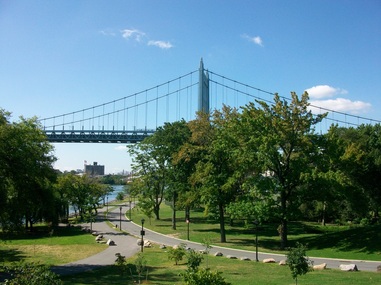Randall's Island Park - New York, NY
Randall's Island Park is a valuable and expansive oasis of open space that commands a unique piece of New York City real estate. The park is comprised of most of an island that is situated in the East River between East Harlem in Manhattan, the South Bronx, and Astoria, Queens. It is definitely in the heart of the city, with such close proximity to three separate boroughs. However, once in the park, the feeling is that you have escaped the city and are in fact isolated from it. Besides the views of city buildings, and the Robert F. Kennedy Bridge that towers above and runs though the park, there is little to remind one hat they are in fact in the middle of the most highly populated city in America. That fact is an extremely valuable asset in which the city is only beginning to fully capitalize upon.
The island is actually two separate islands that have been joined together as a result of landfill, and it forms nearly a square mile of land. The area was first designated for park and recreational use by Robert Moses. In 1936, President Franklin Roosevelt opened the park in correspondence with the new Triborough (now the Robert F. Kennedy) Bridge. As is typical of many parks, public spaces or other institutions throughout New York City, it had fallen into neglect and disrepair by the 1970s and 80s. A park that had once opened to much fanfare and use had become a place with an undesirable reputation and was considered an area to avoid. That was the reality of the entire island until a comprehensive revitalization effort was begun by the city and various partners.
The island is actually two separate islands that have been joined together as a result of landfill, and it forms nearly a square mile of land. The area was first designated for park and recreational use by Robert Moses. In 1936, President Franklin Roosevelt opened the park in correspondence with the new Triborough (now the Robert F. Kennedy) Bridge. As is typical of many parks, public spaces or other institutions throughout New York City, it had fallen into neglect and disrepair by the 1970s and 80s. A park that had once opened to much fanfare and use had become a place with an undesirable reputation and was considered an area to avoid. That was the reality of the entire island until a comprehensive revitalization effort was begun by the city and various partners.
|
Randall's Island is certainly a unique setting for outdoor recreation and tranquility. An elevated interstate highway passes through the park as well as an elevated train line. The island is also home to the Manhattan Psychiatric Center, which is a high-rise hospital for the mentally ill on the edge of the island. Therefore a distinct industrial character permeates parts of the park, which is certainly not always the cases for popular green spaces. The present character and ongoing transformation of the park is largely credited towards the Randall's Island Park Alliance, which was founded in 1992 as a public-private partnership. The Alliance has been tasked with developing a plan for the revitalization as well as its management and operation alongside the New York Department of Parks & Recreation. The plan was introduced in 1999 and has been nearly fully realized.
Since the establishment of the Alliance, miles of pedestrian and bike paths have been restored, including much along the waterfront. Several new and popular sports facilities have also opened. One of the centerpieces of the ongoing construction efforts was the opening of Icahn Stadium in 2005, a modern track-and-field facility. More than 60 playing fields have also been implemented along with a tennis center that features 20 courts. Environmental restoration projects have been present as well, with over nine acres of restored wetlands as a prime example. Overall, the park features several examples of restoring degraded natural areas or utilizing land or structures reclaimed from institutional use. The park is a treasure of New York City, as it is literally a centrally-located island oasis. It is not without its issues though, including limited pedestrian access from East Harlem, which suffers from a lack of adequate open space. Overall, the park could be better served in that aspect, as traveling via car and bus are still the most efficient ways to get to the island. However, the park still provides an incredible natural retreat in the heart of the one the most densely populated areas in the world. Current restoration efforts will continue to bring more to the park, which will increase quality of life throughout the city.
|




